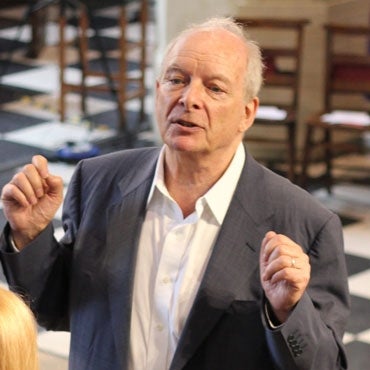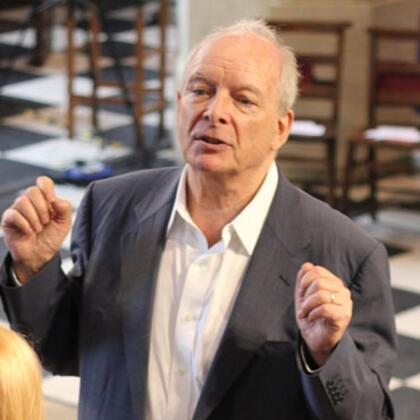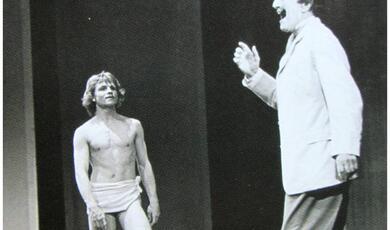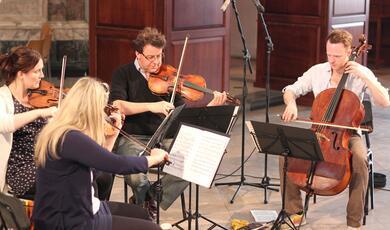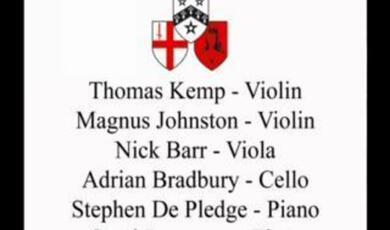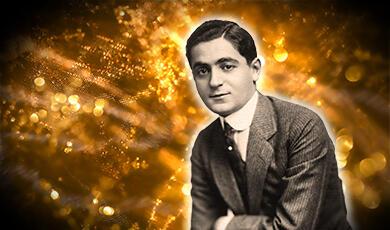27 March 2013
London:
Music under the shadow of Handel
Professor Christopher Hogwood
Good afternoon. Welcome to our first officially spring lecture – you would not think it…! Also, for those of you who are steadfast supporters of this series, you will be happy to know that, at last, we are celebrating London music in a London building. You have had to put up with Vienna for several issues and Paris in the last lecture, and now, you are actually at home in a building suitable and exactly of the right date for the music that we are going to hear.
The obvious thing to have done to celebrate London and music in London would, of course, have been to play choice bits of Handel and to make the usual excuses that Handel was so great and so energetic and lived so long that the rest of musical England rather shrivelled. I do not think that is actually true. I do not think Handel did have a ruinous effect on the rest of musical England, and I think to try and illustrate this point of what it meant to be “in the shadow of Handel”, was not necessarily to be overshadowed but possibly protected by this image. So, we have made a selection of four composers and works from approximately the mid-century, between 1740 and 1750, when this church would have been some twenty years old only. When Handel first arrived in England, this church did not exist. When Geminiani arrived in England, they were just digging the foundations. So, we have music which is very suitably synchronous with the building.
The wrong picture I think we get is that somehow there was incredible rivalry and that the other parts of the musical establishment active in England during Handel’s long career somehow spent their lives complaining about the overshadowing or sniping at this man. I do not think this is at all borne out by the evidence. There was great activity. There was great admiration. Handel certainly was a complete industry to himself. He had certain things he did extremely well and took over: Italian opera being one of them; the devising of the oratorio being another; closeness to the Royal Family being a third great advantage. But it was very rare in the eighteenth century to be considered a classic in your own lifetime. Normally, you had to be dead to have a statue put up, and it is rather noticeable that, when they devised the three statues to stand in the Grand Walk in the Vauxhall Gardens, they picked three important people: Homer, Milton and Handel, and they were on plinths. You can still see the cast of the Roubiliac statue that was the effigy of a very relaxed looking Handel. Interestingly, all three of them were blind, and Handel is the great exception, that he was still living and still regarded as a classic. So, far from having a stifling effect, I think he was the classical eminence under whom a lot of other varieties of musical activity took place.
Since we have, for the first time here, the advantage of a complete orchestra, let us give you an overture to begin with, to sample this activity under Handel’s aegis. This is William Boyce. The overture was written around 1751 and it was for a stage creation he wrote called “The Shepherd’s Lottery”. He later published it in a set of overtures when he was nearing 50. Boyce had a long career as a church musician. He was Master of the King’s Music. He did a number of solid jobs. He was a great supporter of the cathedral music. He did not ever attempt an Italian opera or anything like that, so his path and Handel’s path would be completely different, and his musical language, I think you will notice, is, although baroque, clearly English. I do not know quite how one defines this, except there is a quality which is a green cheerfulness that goes with a lot of English music, and also a slightly military flavour, of a different sort than Handel indulged in when he was writing military-based music. Boyce’s music I think holds the record for having been excerpted more times than any other to provide BBC signature tunes, and so you get some idea of how catchy his melodic fragments are, how attractive the scoring can be – particularly watch out for the bassoon colouring the beginning of the second movement, and then the sheer tunefulness not only of the first movement but of this favourite dance form, the gavotte, which ends the overture.
[Music plays]
Three reasons why music flourished because there was such an overriding presence I think of Handel. One is that the presence of such a great master does create an atmosphere in which others can flourish – it is not a deterrent, and there was such a popularity for the music industry that, when Handel led, others wanted to follow and were given support, particularly from a growing middle-class public who wanted to go to concerts, wanted to hear the latest opera, and moreover, wanted to go home and play this music.
The musical activities of most communities, large cities like London and smaller cities, encouraged the mixing of professionals and amateurs. You have to remember that the amateurs were very often the patrons of the professionals, and the rise of things like music clubs, music societies, small academies, places where people could go and perform music, together with a professional stiffening, meant that you had this culture of house music, in a grand house, music societies, where there were not such grand houses, and a constant demand for the latest and most famous music to be performed.
The popularity of the theatre and opera of course meant that, inevitably, other people, that is the majority who did not have a theatre at their disposal, wanted to perform the same music that had been heard in the opera house in London, hence the publication of sets of overtures like the Boyce you have just heard, but the whole business of a publishing industry was predicated on the idea that there was an enormous market nationwide for music to be performed by this mixture of amateurs and professionals. It was a social event, and one has to remember there was no other way of hearing the music that you had heard rumour of from London than putting the music on your music-stands and performing it.
One of the things I think that we tend to forget is the importance of the music publishing industry, which presented versions of the music heard in the opera house and elsewhere in performable style for perhaps depleted orchestras. I would not call this a large orchestra, but it is, in eighteenth century standards, an orchestra: you have full representation of all the strings and the essential wind instruments – two oboes and a bassoon.
The problem of course, when you picked up your music to perform, in those days, and we shall meet this point in the next music that we hear, by Festing, is that music was not published, on the whole, in scores. It was published, as Pawel has found, discovering the Festing Sonatas, in a form of a printed part. The three performers in the Trio Sonata bought three separate parts: the first violin had her music; the second violin her music; and the continuo group, that is the combination of a cello and a harpsichord, realising the figured bass from a series of numbers. The figured bass is improvised harmony. Nobody could actually see the complete piece. I think sometimes we forget nowadays that we are so used to going to a library and, if you can read music, you can go and buy a score and you can check out a Tchaikovsky symphony or a Beethoven piano trio, and look at it on the page and decide whether or not you think it is worth performing. For much of the eighteenth century, this was not possible, and you found these parts thanks to modern technology…
Pawel: Well, yes, that is right. This music is available in the Petrucci Library, which is an invaluable resource online, called also the International Music Score Library Project, that publishes music out of copyright, available to download from the internet. This music is in its original print. As you said, there is no score, so when I was choosing the Sonata, I had to try to look simultaneously at three pages, which was not easy, and then imagine the violin part while I was playing the bass part.
A meeting of high-tech and musicology, which is rather nice. Anybody can go online and look at this enormous archive and I think anybody would be envious in previous generations, to have had access to quite so much music free of charge, as you say, in its original editions. This bases itself on being out of copyright, which gives us exactly what we want, which is the original music, untampered by any later editor. But it does mean that you have to carry in your head what the music is doing.
I think, mostly, people just went out and bought a set of Trio Sonatas. They had heard that Michael Christian Festing was the most famous violinist on the London scene. He led most of the orchestras, he led the Pleasure Gardens’ orchestras, he was a famous teacher, he had a strong following for his theatre music, and when you heard that a new set of Trio Sonatas had appeared, you bought them. I think, in a certain sense, that you knew that the Trio Sonata was a user-friendly combination. You might wonder why it is a trio sonata, but you easily can see there are only three parts, although there are four or more performers, but three written lines. It did not carry with it the expectations of what the eighteenth century would have a termed a solo sonata. Solo sonatas meant one instrument showing off, with an accompaniment probably for continuo, so harpsichord with or without cello, but they were designed to test your technique. Trio sonatas were much more the eighteenth century sense of sociability in music, where you would discuss a point.
Festing, I think, is an interesting man. I am pretty sure many people will never have heard the name before, but here he is, just a few years before the Boyce that you have just heard, producing a set of Trio Sonatas which take considerable liberties with harmony, go out of their way not to be Handelian, I think. Would you agree with that, and what other features did you find in this when you explored it?
Pawel: It is on the verge of different styles actually. When we played through this sonata during the rehearsals, there is lots of baroque, but there are unexpected different modulations which put it a little bit on the edge of the new Galant style, so a very emotional style. There are a couple of bars which actually resemble, to us, resembled later classical periods, so this music is really looking forward. Still, in the construction, it is based on the traditional baroque trio sonata, with a figured bass, all the way through, and two treble instruments dialoguing.
It raises the question of whether actually music can look forward to anything or whether this is just our way of describing this sort of plagiarism of the future that people like to impute to composers. I am quite sure the composers at that time did not feel they were on the verge of a new era and I think we perhaps can clear our minds of this idea of subdivided segments in eighteenth century history. It was a moving target. Handel was a bit older than you and therefore maybe a bit more old-fashioned. He had come from a different culture, and therefore brought with him other things. The English players came from a different background, were writing for a different audience, had the advantage of seeing in London probably the greatest cross-section of international music you could find anywhere in the world, so French musicians, and dancers and theatre people, and Italian players and Italian singers, and a whole galaxy of international musicians would meet up in what was then essentially quite a small, concentrated central portion of London where musicians congregated. It is quite clear that the ideas would cross-fertilise. So, what surprises me, more than the fact that it does reflect its feet in an earlier style, is that it does not seem to me to call up any particular images of those little catchphrases that we all know of as typically Handel. I think everybody knows certain cadences, certain melodic styles, which you know are the fingerprints of Handel, and yet, with Handel lauding it over this culture for half a century, you still find people working in, as you say, a more emotional style.
Pawel: Yes, very original style.
A very original style – there are some wonderful moments where Festing suddenly shifts the harmony up by one tone, like this, very rudely, something Handel would never, ever, ever do, into a new world, and also some elegant rhythmic tricks which you could say possibly are Scottish, these snapping rhythms, ta-dum-ta-dum-ta-dum, Scottish snaps and things like that you find in the last movement, particularly, of this little piece.
Pawel: The bass line is very, very interesting. It is also nothing like Handel’s bass line. It is very unexpected in its turns and turning of the corners. There is also reference to a different set of dances. The third movement starts a little bit like a loure, like a sort of flamboyant French dance, but then it immediately changes into something completely else, maybe more like a minuet – very interesting.
It is volatile. Another feature, I find, of a lot of the composers who worked alongside Handel is this volatility. They did not settle into any one particular slot. Let us hear the Sonata: four movements, two violins, one cello and one harpsichord. The adding of rests to a part, which you would have thought is a cop-out for a composer, is actually a very subtle business, where to allow a trio sonata to lose a voice and to introduce it again. There is a certain intensity I find to Festing, that he keeps all the voices going all the time. He is determined that this social gathering is going to get value for money with its Trio Sonata…
[Music plays]
A very distinct voice of a very non-Handelian voice and a voice of English music in the 1740s. One has to remember the huge foreign element that co-existed with these composers and players, and, sometimes, the expectations people held of foreign visitors were not fulfilled. The next composer, Geminiani, is a perfect example I think of this.
Geminiani was probably the most famous violinist in the world. He was the star pupil of Corelli, whose music had completely overrun the musical world at the beginning of the eighteenth century. He arrived in England, as I said, the year that this church was built, and he came in the expectation of being an art dealer. He did not want to deal in music at all – he thought it was very suspect. He loved paintings and thought he could live much more happily by trading in pictures. Unfortunately, everybody knew he was the star violinist and asked for concerts, and Geminiani refused. He was only, in the end, persuaded to perform at court by royal command. Even that, he was on the point of turning down, but said he would consent to play providing Handel accompanied him. Handel agreed, which tells you something of what Geminiani must have been like.
His whole career was more international, I think, than any other composer. We think of Handel as being a traveller, working in Italy and ending up in England, but with his German training. Geminiani started in Lucca, trained in Rome, roamed about – excuse the pun – ended in Paris for quite a few years, was a friend of Ramou, came to England, went to Ireland, came back to London, went probably to Spain for a while, where his brother was the chief violinist in the Royal Orchestra in Madrid.
He was said to speak every European language. He was a great teacher. He spent as much of his life writing texts on how to compose and perform as he did composing and writing music. In fact, he turned out far less music than the public were expecting, and whereas the critics had received him with open arms, they gradually decided that he was not behaving in the way a star performer ought to behave. First of all, he was refusing to give concerts. When he did, they were very badly organised.
He tended to lose money. He would retire home, and he would sell paintings in large auction sales which were reported by Charles Burney and John Hawkins, the major historians and critics, as being huge failures, but in fact turn out to have been vastly successful. He had an enormously effective eye for paintings of all periods, particularly French paintings, from his time in Paris, and did rather well. He built himself a large art gallery in Dublin, where he also gave some concerts.
Nobody was quite sure ever where he was, what he was going to do next, whether he was going to compose any more music, and they were even not sure how old he was. He was reported by a lot of people to be in his nineties, when in fact he was only 70. He mystified almost all of Europe, and he produced some music which I think is extraordinarily individual.
Here is a sample from one of his set of six cello sonatas. You might think what is a famous violinist doing writing cello music? Well, let us ask a cellist – does it fit the cello, this music?
Cellist: Yes, I think it does fit the cello.
It does not feel like a violinist transposing down for a cello?
Cellist: No. I mean, you can quite often tell when that happens, and it does feel that he does know what he is doing, but it is incredibly fiddly on the cello and I do not know whether that is going anything to do with transposing from the violin to the cello…
No, he wrote these originally for the cello.
Cellist: Yeah.
And then adapted afterwards…
Cellist: Yeah.
Would you guess that it was Italian when you first saw it, or might it pass as French?
Cellist: I think, looking at it on a page, you would think it is French, and then, playing it, then you would not be so sure. You might think there is some Italian stuff in here, and then, after that, you would probably think, now, I have no idea what it is!
Do you have to add a lot to this music to make it make sense or is it all notated?
Cellist: If you played what was on the page, you would have yourself occupied and it does not need any more than is there, but I know that he was famous for quite a lot of improvisation and things like that, so it is likely that how he would have liked them performed is very different to how they look on the page, although they do work as they are on the page as well.
Right. I think you add a little cadenza to link these two movements together which makes a little transition…
Cellist: Yes.
That is very Italianate in style and very appropriate.
Geminiani had his 250th anniversary last year. I think nobody noticed this at all. He escaped. He seems to me one of the missing names that ought to be reflected, and particularly in the society of people ploughing their own furrow, very deliberately, in disregard of what Handel was telling them, and I think, of all the composers who most showed up as an individual, surely it was Geminiani, the art dealer.
So, here are two movements from Sonata 3, from his set of six cello sonatas…
[Music plays]
You might have imagined that gavotte was a tribute to William Boyce, the gavotte that ended that overture that we began with, but in fact, this gavotte is several years earlier than Boyce, so there is no sense of following with Geminiani. He goes his own way, and you will notice that, contrary to most composers, including Handel, there is a great lack of symmetry in his music. Whereas Handel is nicely architectural, A section, B, and then a repeat of the A section, everything is in its place and secure and politically correct, Geminiani tends to have A followed by B, followed by C, followed by D, followed by maybe a reminder of A, followed by E and F. It was a stream of consciousness, and his compositions, as a result, are evasive, in a way that we cannot very easily analyse them. You will hear more Geminiani smuggled in for our next lecture, the final one of the series, which, although it features Corelli, will have some concerto arrangements by Geminiani of his teacher’s music. That will be in May.
For the final round-up though of the Englishness under the umbrella of Handel, there are a few other concepts that we have to consider about the musician’s life. One of them comes up when you trace Geminiani’s career, what he did do and did not do. He was a Catholic. He was offered the job of Master of the Music in Dublin, which was of course Anglo-Irish domination, and he turned it down because he would have been required to forego his religion. So, there were barriers to rising in the English musical world. Handel, for example, not being born English, could not become Master of the King’s Music – that was William Boyce. He got a long way because people did say it was rather foolish, seeing as we already had a German King, why not have a German composer celebrating him, but in terms of ritual and protocol, there were certain jobs reserved for English-born, English Church, and Geminiani certainly did not tick any of those boxes. In fact, Geminiani ticked very few boxes of any nature.
Thomas Augustine Arne, who we all know and love for Rule Britannia and famous patriotic songs, also suffered from the same problem: he was Catholic, therefore he could not ever have a court job. He was never employed, as William Boyce was, writing church music. His life was more or less restricted to theatre music, entertainment music, the public gardens, and music for amateurs. He was described by John Stafford Smith, who was perhaps the first ever musicologist, he knew Arne quite well and he described him as “a conceited Papist, an evil-living man, but a God-gifted genius for melody”, which is rather a nice one-sentence summary, all of them true. He did behave very badly to various wives, he was very conceited, he certainly was a Papist, but, as we know from all the tunes we are brought up with, he had this knack of writing melodies.
He occupied himself with theatre music, where his skills led him towards something that never really took off, which was grand opera with English text. It was unfortunately sabotaged by other forms of theatrical entertainment, like the masque and, more to the English taste, pantomime, and ballad opera – more entertaining, with mixed speech as well as set music, that people felt was lighter on the ear and on the intellect than the demands of a full Italian opera seria. So, we find Arne recycling his music that he composed for the theatre in exactly the same way as Boyce did with the first overtures, for the delight of the musical public, and the musical public, as we said, would be a gentlemanly club of amateurs mixed with professionals, not, I hasten to say, the sample we have here, but I think of perhaps the same size and directed by the local professional music-maker.
How does one run an orchestra like this, when you do not have the trappings of a modern symphonic tradition or the tradition of conducting? How does one begin putting together an orchestral performance from colleagues?
Pawel: It is a very ensemble-like or chamber music experience, in a way. I think it is very different from modern symphonic orchestra, that everyone takes charge of their part, and I think the role of a director is to inspire and take the best from everyone, and also hope that everyone will be listening to each other and to one another, rather than just observing and watching the director or listening to him. So, of course, there are certain decisions that have to be made, and especially if there are more choices in this music – not everything is written down, so lots of it is interpretation. There are certain decisions and someone has to take those decisions, but I feel that, if I feel a little bit of protest from the musicians, that probably means it is not the right one. It is more of an inspiring leadership, I would say, than imposing any of the ideas.
Can it be called democratic?
Pawel: In a way
Do you feel this way of running an ensemble is everybody has an equal voice, or does it demand to have a director? Because there is always a question in my mind about a lot of these eighteenth century groupings: was anybody actually in charge? If the composer was there, you assume you would rely on him for the final word, but if not, could it be whoever was leading or whoever had the topmost melody?
Pawel: I think we are going back to the issue of being a chamber musician, so really making the music together. I think it was not the matter of just a democratic decision; it is more of the artistic judgement and really listening to what is happening and reacting to that immediately. So, yes, I assume that there might have been one person in charge, be that composer or a leader or maybe a bass player, but not maybe so autocratic.
You do not think it would be a viola player who would take charge?
Pawel: Well, why not?! I mean, we have an excellent viola player so…
I like the way the viola is always omitted from these directorial positions! Another thing I wonder about eighteenth century music is: do you think it was ever rehearsed as much in the eighteenth century as it is today?
Pawel: Probably not. I mean, I think that there was rehearsal with the soloists, if there were any, if it was stage work, but in terms of the whole, the complete orchestral rehearsal, I do not think that was happening to the extent we are doing it now. So, we tend to pay attention to all the minute details being together, playing absolutely in tune, trying, and just having a vertically aligned ensemble. I think the music-making in the eighteenth century was a little bit more alive. The other thing is that people were immersed in that style. That was not a style that they learnt, retrospectively as it were. So, of course, they did certain things maybe a little bit more intuitively than we do them today, having all the weight of the next generations in music-making.
It is a difficulty I find with trying to direct eighteenth century music with a suitably social sense of democracy, that one spends a lot of one’s time saying no, simply because players today have a much greater range of styles available to them, and they might flip, by accident, into the style more suitable to Tchaikovsky, and they have to be warned off this, in a way that the eighteenth century player could never go wrong, exactly in the same way as a jazz player can never play a wrong note, or somebody playing pop music never makes a mistake or misreads – whatever you do is right, because it is your style and you have created it and it is the style now, whereas, as you say, we have this tendency to look at the questions of should we be doing this, should we not be doing this, should you be over-dotting, should you be adding cadenzas, should you be adding dynamics, taking new bowing patterns etc.
Pawel: Yes.
So, we have four movements of Arne in this.
Pawel: Just one extra word about that is that we are using historical instruments, we are using period instruments, and I think that also is to our advantage because there are certain things that those instruments dictate, they suggest, and that is maybe easier because working with people who play baroque instruments and know the style…
You mean they are Tchaikovsky-proof?!
Pawel: Yes!
They cannot lead you astray! Yeah, you can push them quite a long way in the wrong direction, I find…
Pawel: Yes, you can, that is right, that is right!
And, as you say, one has but to rely on what the instrument tells you is a considerable safeguard.
Pawel: Yes.
Let’s put the orchestra together again and just introduce its components to people because we never mentioned the various instruments.
Pawel: Yes.
We have oboe, two oboes, and bassoon, which we should pick out, for those who did not…
Pawel: Yes, we have got the baroque bassoon, and two oboes. We have got a string quartet: two first violins, two second violins, viola, double-bass and cello. This is a continuo section, so one, two, three, four of us, including the harpsichords, so cello, double-base, bassoon and harpsichord, we play one line, the bass line, occasionally slightly varied for the bassoon part, which is really lovely, extra colour, and we have the treble instruments all interlocked together.
[Music plays]
© Professor Christopher Hogwood, 2013


 Login
Login
